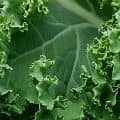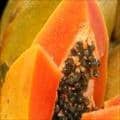Vitamin C
mail this page to a friendBookmark & Share Printer-friendly version
Vitamin C is a water-soluble vitamin that is necessary for normal growth and development.
Water-soluble vitamins dissolve in water. Leftover amounts of the vitamin leave the body through the urine. That means you need a continuous supply of such vitamins in your diet.
Water-soluble vitamins dissolve in water. Leftover amounts of the vitamin leave the body through the urine. That means you need a continuous supply of such vitamins in your diet.
Function
Vitamin C is needed for the growth and repair of tissues in all parts of your body. It is used to:- Form an important protein used to make skin, tendons, ligaments, and blood vessels
- Heal wounds and form scar tissue
- Repair and maintain cartilage, bones, and teeth
- Free radicals are made when your body breaks down food or when you are exposed to tobacco smoke or radiation.
- The buildup of free radicals over time is largely responsible for the aging process.
- Free radicals may play a role in cancer, heart disease, and conditions like arthritis.
For many years, vitamin C has been a popular remedy for the common cold.
- Research shows that for most people, vitamin C supplements or vitamin C-rich foods do not reduce the risk of getting the common cold.
- However, people who take vitamin C supplements regularly might have slightly shorter colds or somewhat milder symptoms.
- Taking a vitamin C supplement after a cold starts does not appear to be helpful.
Side Effects
Serious side effects from too much vitamin C are very rare, because the body cannot store the vitamin. However, amounts greater than 2,000 mg/day are not recommended because such high doses can lead to stomach upset and diarrhea.Too little vitamin C can lead to signs and symptoms of deficiency, including:
- Anemia
- Bleeding gums
- Decreased ability to fight infection
- Decreased wound-healing rate
- Dry and splitting hair
- Easy bruising
- Gingivitis (inflammation of the gums)
- Nosebleeds
- Possible weight gain because of slowed metabolism
- Rough, dry, scaly skin
- Weakened tooth enamel
Recommendations
The Recommended Dietary Allowance (RDA) for vitamins reflects how much of each vitamin most people should get each day. The RDA for vitamins may be used as goals for each person.How much of each vitamin you need depends on your age and gender. Other factors, such as pregnancy and illnesses, are also important.
The best way to get the daily requirement of essential vitamins, including vitamin C, is to eat a balanced diet that contains a variety of foods.
Dietary Reference Intakes for vitamin C:
Adults
- Men age 19 and older: 90 mg/day
- Women age 19 year and older: 75 mg/day
Top 10 Foods Highest in Vitamin C
#1: Red and Green Hot Chili Peppers An excellent way to spice up soups, curries, and sauces, green chillies provide the most
vitamin C than any other food with 242.5mg (404% DV) per 100 gram serving, 181.88mg (303% DV) in a half cup chopped,
and 109.13mg (182% DV) in a single green chili pepper.
Red chillies provide 144mg (240% DV) of vitamin C per 100g
serving, 108mg (180% DV) per half cup chopped, and 65mg (108% DV) per pepper.
An excellent way to spice up soups, curries, and sauces, green chillies provide the most
vitamin C than any other food with 242.5mg (404% DV) per 100 gram serving, 181.88mg (303% DV) in a half cup chopped,
and 109.13mg (182% DV) in a single green chili pepper.
Red chillies provide 144mg (240% DV) of vitamin C per 100g
serving, 108mg (180% DV) per half cup chopped, and 65mg (108% DV) per pepper.#2: Guavas
 Depending on variety, guavas can provide as much as 228mg (381% DV) of vitamin C per 100g serving,
377mg (628% DV) per cup, and 126mg (209% DV) per fruit.
Depending on variety, guavas can provide as much as 228mg (381% DV) of vitamin C per 100g serving,
377mg (628% DV) per cup, and 126mg (209% DV) per fruit.#3: Bell Peppers
 A staple of pasta sauce and pizza the sweet bell pepper packs a high
vitamin C punch. The amount of vitamin C depends on color. Yellow
peppers provide the most vitamin C with 184mg (206% DV) per 100 gram
serving, 341mg (569% DV) per pepper, and 95mg (159% DV) in 10 sliced
strips.
Green peppers provide the least vitamin C with 132mg (220% DV) per
pepper.
A staple of pasta sauce and pizza the sweet bell pepper packs a high
vitamin C punch. The amount of vitamin C depends on color. Yellow
peppers provide the most vitamin C with 184mg (206% DV) per 100 gram
serving, 341mg (569% DV) per pepper, and 95mg (159% DV) in 10 sliced
strips.
Green peppers provide the least vitamin C with 132mg (220% DV) per
pepper.
#4: Fresh Herbs (Thyme and Parsley)
 Fresh and dried herbs are packed with vitamins and health benefits, they can be used in almost any soup, stew,
or as the main ingredient to a salad like tabouleh. Thyme
provides the most vitamin C of any herb with 160mg (267% DV) per 100 gram serving, 1.6mg (3% DV) in a single teaspoon.
Parsley provides 133mg (222% DV) per 100 gram serving, 79mg (133% DV) per cup, 5mg (9% DV) per tablespoon,
13.3mg (22% DV) in 10 sprigs.
Fresh and dried herbs are packed with vitamins and health benefits, they can be used in almost any soup, stew,
or as the main ingredient to a salad like tabouleh. Thyme
provides the most vitamin C of any herb with 160mg (267% DV) per 100 gram serving, 1.6mg (3% DV) in a single teaspoon.
Parsley provides 133mg (222% DV) per 100 gram serving, 79mg (133% DV) per cup, 5mg (9% DV) per tablespoon,
13.3mg (22% DV) in 10 sprigs.#5: Dark Leafy Greens (Kale, Mustard Greens, Garden Cress)
 Dark leafy greens are more than just a source of calcium, and are packed
with other vitamins including
vitamin C. Raw kale provides the most vitamin C with 120mg (200% DV) per
100 gram serving, 80mg (134% DV) per
cup chopped. It is followed by mustard greens which provide 70mg (117%
DV) per 100 gram serving, and 29mg (65% DV) per cup chopped. Garden
cress provides 69mg (115% DV) per 100 gram serving, or 35mg (58% DV) per
cup.
Dark leafy greens are more than just a source of calcium, and are packed
with other vitamins including
vitamin C. Raw kale provides the most vitamin C with 120mg (200% DV) per
100 gram serving, 80mg (134% DV) per
cup chopped. It is followed by mustard greens which provide 70mg (117%
DV) per 100 gram serving, and 29mg (65% DV) per cup chopped. Garden
cress provides 69mg (115% DV) per 100 gram serving, or 35mg (58% DV) per
cup.#6: Broccoli, Cauliflower, Brussels Sprouts
 Broccoli provides 89mg (149% DV) of vitamin C in a 100g serving, 81mg (135% DV) per cup chopped,
28mg (46% DV) per piece. Raw cauliflower provides much less with 46mg (77% DV) per cup, raw brussles sprouts
provide 75mg (125% DV) per cup, 16mg (27% DV) per sprout.
Broccoli provides 89mg (149% DV) of vitamin C in a 100g serving, 81mg (135% DV) per cup chopped,
28mg (46% DV) per piece. Raw cauliflower provides much less with 46mg (77% DV) per cup, raw brussles sprouts
provide 75mg (125% DV) per cup, 16mg (27% DV) per sprout.
#7: Kiwi Fruits (Chinese Gooseberries)
 Kiwi fruits are tart as well as decorative, they
make a great addition to any fruit salad or dessert.
A 100g serving will provide 93mg (155% DV) of vitamin C, that is 164 mg (273% DV) per cup, 84mg (141% DV) per
fruit.
Kiwi fruits are tart as well as decorative, they
make a great addition to any fruit salad or dessert.
A 100g serving will provide 93mg (155% DV) of vitamin C, that is 164 mg (273% DV) per cup, 84mg (141% DV) per
fruit.#8: Papayas (aka: Lechoza, Mamão, Pawpaw)
 In addition to vitamin C, papaya is also
a great source of vitamin A and folate (vitamin B9). Papaya provides 62mg (103% DV) per 100 gram serving, that
is 87mg (144% DV) per cup cubed, and 188mg (313% DV) in a medium sized papaya.
In addition to vitamin C, papaya is also
a great source of vitamin A and folate (vitamin B9). Papaya provides 62mg (103% DV) per 100 gram serving, that
is 87mg (144% DV) per cup cubed, and 188mg (313% DV) in a medium sized papaya.
#9: Oranges and Clementines (Tangerines)
 Oranges, citrus fruits, and their zest (the shavings
of their peel) are all high in vitamin C. Oranges provide 59mg (99% DV) per 100 gram serving, 98mg (163% DV) per
cup, and 83mg (138% DV) per orange. Clementines, or tangerines, provide 49mg (81% DV) per 100 gram serving, or
36mg (60% DV) per fruit.
Oranges, citrus fruits, and their zest (the shavings
of their peel) are all high in vitamin C. Oranges provide 59mg (99% DV) per 100 gram serving, 98mg (163% DV) per
cup, and 83mg (138% DV) per orange. Clementines, or tangerines, provide 49mg (81% DV) per 100 gram serving, or
36mg (60% DV) per fruit.#10: Strawberries
 Strawberries are delicious and make a
great addition to desserts or drinks. Strawberries provide 59mg (98% DV) per 100 gram serving, 98mg (163 % DV) per
cup slices, and 11mg (18% DV) in a single large strawberry.
Strawberries are delicious and make a
great addition to desserts or drinks. Strawberries provide 59mg (98% DV) per 100 gram serving, 98mg (163 % DV) per
cup slices, and 11mg (18% DV) in a single large strawberry.

No comments:
Post a Comment